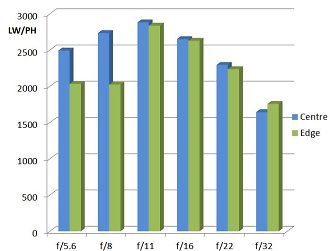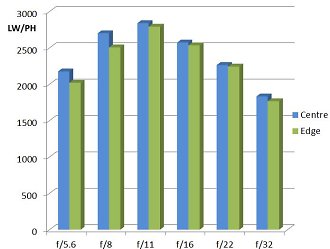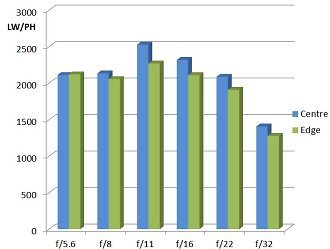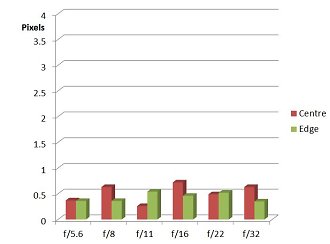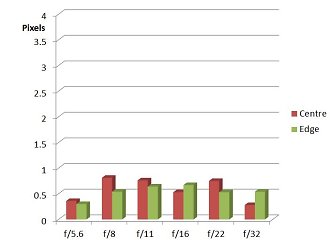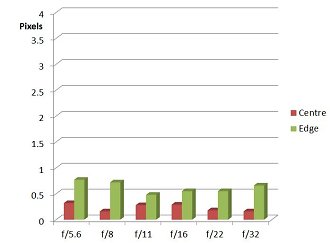Nikon AF-S NIKKOR 200-500mm f/5.6E ED VR Review
Nikon AF-S NIKKOR 200-500mm f/5.6E ED VR Performance
All the pleasure of using the lens would be for nought if the performance were not up to scratch, so it is good to report that the lens delivers crisp, saturated images free from flare. Performance does dip as we zoom in, but the maximum aperture remains usable throughout the range.
At all focal lengths the optimum apertures are f/8 to f/16, where image quality is very good across the frame and approaches excellent. There is fall off at the widest aperture, but performance is still very good. f/32 is by far the weakest aperture, being fair to good but limited by diffraction effects. It is still useful to have the option to gaining some depth of field, but it is at a price optically.
How to read our charts
The blue column represents readings from the centre of the picture frame at the various apertures and the green is from the edges.The scale on the left side is an indication of actual image resolution as LW/PH. The taller the column, the better the lens performance. Simple.
For this review, the lens was tested on a Nikon D750 using Imatest.
What is particularly impressive is the evenness of the performance across the frame. The amount of CA and distortion are also impressively low. There is a small amount of pincushion distortion, 0.439% at 200mm, 0.559% at 300mm, 0.657% at 400mm and 0.574% at 500mm. This should not present any problem with most subjects.
How to read our charts
Chromatic aberration is the lens' inability to focus on the sensor or film all colours of visible light at the same point. Severe chromatic aberration gives a noticeable fringing or a halo effect around sharp edges within the picture. It can be cured in software.Apochromatic lenses have special lens elements (aspheric, extra-low dispersion etc) to minimise the problem, hence they usually cost more.
For this review, the lens was tested on a Nikon D750 using Imatest.
Subjectively, images from the lens were excellent throughout the range. Maximum aperture was used quite a bit as it is usually desirable to stop movement in wild animals and other action shots. Stopping down a notch or two might result in sharper images but that is a choice to be made.
When using a lens this long making sure backgrounds can be kept out of focus is not too difficult. The bokeh is very smooth and very nice indeed. This is helped by the 9 blade diaphragm, which gives attractive round highlights.
Value For Money
The Nikon 200-500mm compares very favourably, costing around £1179, compared to the £1799 price tag for the Nikon 80-400mm F4.5-5.6G ED VR AF-S Nikkor lens. It also compares favourably with the lenses available for other marques, Canon's 100-400mm costing £1849 and Pentax's 150-450mm costing £1599.
Sigma offers a 50-500mm (£799), 150-600mm Sport (£1399) and it is worth noting that the Sigma 150-600mm Contemporary can be found at £799. Tamron has the 150-600mm at £799.
Third party lenses give a wide degree of choice, but for those wanting a marque lens the Nikon 200-500mm does offer good value for money. For more options have a look at to Top 10 Best Nikon Lenses of 2015.
Add your message
Please login here or if you've not registered, you can register here. Registering is safe, quick and free.
photodo Stats
428 MTF tests
74 in-depth photodo reviews
100+ users join each day
Help the lens community by reviewing or rating a lens today via our lens search
Latest Lens Reviews
- Chinon 28mm f/2.8 Vintage Lens Review
- Canon EF 70-200mm f/4L IS II USM Lens Review
- Samyang AF 85mm f/1.4 EF Review
- Sigma 70mm f/2.8 DG Macro Art Review
- Samyang AF 24mm f/2.8 FE Review
- Meike 50mm f/1.7 Review
- Tamron 70-210mm f/4 Di VC USD Review
- Lensbaby Burnside 35mm f/2.8 Review
- Asahi Super Takumar 50mm f/1.4 Review
- Asahi Super-Multi-Coated Takumar 135mm f/3.5 Review
